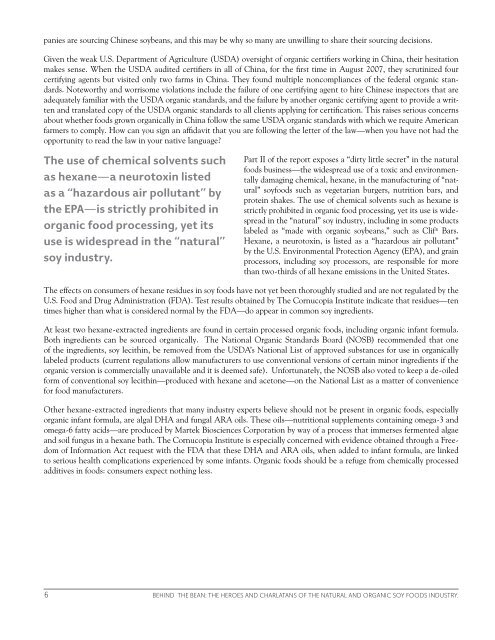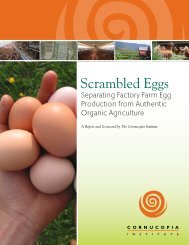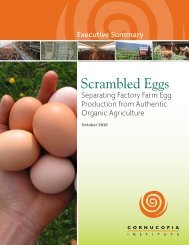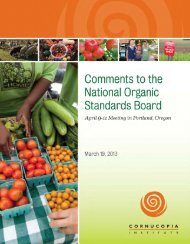“Behind the Bean” (pdf) - Cornucopia Institute
“Behind the Bean” (pdf) - Cornucopia Institute
“Behind the Bean” (pdf) - Cornucopia Institute
Create successful ePaper yourself
Turn your PDF publications into a flip-book with our unique Google optimized e-Paper software.
panies are sourcing Chinese soybeans, and this may be why so many are unwilling to share <strong>the</strong>ir sourcing decisions.<br />
Given <strong>the</strong> weak U.S. Department of Agriculture (USDA) oversight of organic certifiers working in China, <strong>the</strong>ir hesitation<br />
makes sense. When <strong>the</strong> USDA audited certifiers in all of China, for <strong>the</strong> first time in August 2007, <strong>the</strong>y scrutinized four<br />
certifying agents but visited only two farms in China. They found multiple noncompliances of <strong>the</strong> federal organic standards.<br />
Noteworthy and worrisome violations include <strong>the</strong> failure of one certifying agent to hire Chinese inspectors that are<br />
adequately familiar with <strong>the</strong> USDA organic standards, and <strong>the</strong> failure by ano<strong>the</strong>r organic certifying agent to provide a written<br />
and translated copy of <strong>the</strong> USDA organic standards to all clients applying for certification. This raises serious concerns<br />
about whe<strong>the</strong>r foods grown organically in China follow <strong>the</strong> same USDA organic standards with which we require American<br />
farmers to comply. How can you sign an affidavit that you are following <strong>the</strong> letter of <strong>the</strong> law—when you have not had <strong>the</strong><br />
opportunity to read <strong>the</strong> law in your native language?<br />
The use of chemical solvents such<br />
as hexane—a neurotoxin listed<br />
as a “hazardous air pollutant” by<br />
<strong>the</strong> EPA—is strictly prohibited in<br />
organic food processing, yet its<br />
use is widespread in <strong>the</strong> “natural”<br />
soy industry.<br />
Part II of <strong>the</strong> report exposes a “dirty little secret” in <strong>the</strong> natural<br />
foods business—<strong>the</strong> widespread use of a toxic and environmentally<br />
damaging chemical, hexane, in <strong>the</strong> manufacturing of “natural”<br />
soyfoods such as vegetarian burgers, nutrition bars, and<br />
protein shakes. The use of chemical solvents such as hexane is<br />
strictly prohibited in organic food processing, yet its use is widespread<br />
in <strong>the</strong> “natural” soy industry, including in some products<br />
labeled as “made with organic soybeans,” such as Clif ® Bars.<br />
Hexane, a neurotoxin, is listed as a “hazardous air pollutant”<br />
by <strong>the</strong> U.S. Environmental Protection Agency (EPA), and grain<br />
processors, including soy processors, are responsible for more<br />
than two-thirds of all hexane emissions in <strong>the</strong> United States.<br />
The effects on consumers of hexane residues in soy foods have not yet been thoroughly studied and are not regulated by <strong>the</strong><br />
U.S. Food and Drug Administration (FDA). Test results obtained by The <strong>Cornucopia</strong> <strong>Institute</strong> indicate that residues—ten<br />
times higher than what is considered normal by <strong>the</strong> FDA—do appear in common soy ingredients.<br />
At least two hexane-extracted ingredients are found in certain processed organic foods, including organic infant formula.<br />
Both ingredients can be sourced organically. The National Organic Standards Board (NOSB) recommended that one<br />
of <strong>the</strong> ingredients, soy lecithin, be removed from <strong>the</strong> USDA’s National List of approved substances for use in organically<br />
labeled products (current regulations allow manufacturers to use conventional versions of certain minor ingredients if <strong>the</strong><br />
organic version is commercially unavailable and it is deemed safe). Unfortunately, <strong>the</strong> NOSB also voted to keep a de-oiled<br />
form of conventional soy lecithin—produced with hexane and acetone—on <strong>the</strong> National List as a matter of convenience<br />
for food manufacturers.<br />
O<strong>the</strong>r hexane-extracted ingredients that many industry experts believe should not be present in organic foods, especially<br />
organic infant formula, are algal DHA and fungal ARA oils. These oils—nutritional supplements containing omega-3 and<br />
omega-6 fatty acids—are produced by Martek Biosciences Corporation by way of a process that immerses fermented algae<br />
and soil fungus in a hexane bath. The <strong>Cornucopia</strong> <strong>Institute</strong> is especially concerned with evidence obtained through a Freedom<br />
of Information Act request with <strong>the</strong> FDA that <strong>the</strong>se DHA and ARA oils, when added to infant formula, are linked<br />
to serious health complications experienced by some infants. Organic foods should be a refuge from chemically processed<br />
additives in foods: consumers expect nothing less.<br />
6 Behind <strong>the</strong> bean: The Heroes and Charlatans of <strong>the</strong> Natural and Organic Soy Foods Industry.





